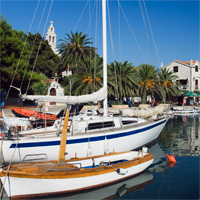There are now reckoned to be at least 3, 600 charter companies worldwide, offering more than 10,750 models of yacht in 664 sailing areas. It’s easy to see why the chartering business is on the crest of a wave. The biggest advantage over buying a boat outright is the huge cost difference. Today’s superyachts can cost up to £120m, which is what Microsoft billionaire Paul Allen paid for his 414ft-long Octopus.
There’s an old saying that a boat owner only has two good days – the day he buys it and the day he sells it, because there are a multitude of “hidden” running expenses such as mooring fees, winter storage, insurance, maintenance, and, if you buy a superyacht, the crew’s wages.
It isn’t just about finance, though. Part of the reason for the increased popularity of chartering is the way it now embraces the corporate business world as well as leisure and holiday markets. And for many prospective yacht owners, chartering is the perfect way to try before they buy.
As Stuart Carruthers, cruising manager of the Royal Yachting Association, says: “You can charter a boat for several weekend or weeks a year with none of the responsibilities.”
To many enthusiasts, the sheer freedom of chartering is the main attraction. When it comes to destination, there are no horizons. A picturesque break around the British Isles, the sunshine of the Mediterranean or Pacific, secluded beaches of the Caribbean, the peace of the open sea…there are a host of charter companies willing to turn these dreams into reality.
In the business world, sales of corporate days and events afloat have never been more buoyant. Team building on the water is becoming increasingly popular as a method of testing and extending the abilities of leadership, communication, initiative and team bonding.
Companies such as Southampton-based Corporate Yachting (website here) provide sailing events embracing client entertainment, team building, staff incentives and rewards, along with corporate charters for major regattas such as Cowes Week.
For holidays and pleasure sailing, chartering divides into four areas:
1. Bareboat, with a nominated skipper who is experienced and takes full liability for the safety of crew and vessel. Bigger yachts (over 40ft) are best with a skipper and two experienced crew members.
2. Crewed, a vessel with a qualified skipper and crew are hired to take charge and direct responsibility.
3. Skippered, where a qualified captain is hired with the vessel and is responsible for the safety of you and the yacht. One crew member must have previous knowledge, as assistance with boat handling duties may be required.
4. Flotilla, where you sail on one of a number of vessels under the supervision of a lead boat. Sailing knowledge is essential for the nominated skipper but flotilla sailing is the perfect introduction for yacht “rookies.”
For charter abroad it is best to go with one of the established companies or on personal recommendation, although the U.K.-based website www.yachtcharterguide.com offers probably the most comprehensive global guide.
Ten years ago, a big yacht was classed as about 165ft but vessels like these are now commonplace on the French Riviera. There are around 3,000 yachts that are more than 100ft and that figure increases by ten per cent each year.
Luxury yachts are the current celebrity accessory. The Beckhams celebrated their recent wedding anniversary on a £20m 134-fit yacht borrowed from designer Robert Cavalli. Cavalli’s wife Eve pointed out: “It allows you to keep your distance.”
Other celebs who have chartered recently include rapper P. Diddy, who held a £675,000 party on a yacht at St Tropez, and Rod Stewart and Penny Lancaster, who displayed their baby son while sailing around the Med.





